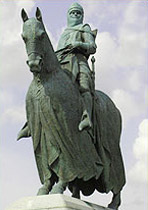Clan Cumming People
John Comyn d.c.1303
‘The Black Comyn’ was born the son of John ‘the Red’ of Badenoch and Tynedale. The Comyn family were enjoying the height of their power when Margaret, Maid of Norway died in 1290. There were 13 claims to her throne and Comyn was one of the ‘competitors’ based on the descent of Donald Ban.
John Balliol’s sister Eleanor became his wife and in 1295 he worked with his brother in law to renew the ‘Auld Alliance’ with France. This brought Edward I over the border in 1296 and Comyn aided Balliol with refuge in Badenoch. Balliol abdicated however and Comyn fond himself a prisoner in England.
When the Earl of Buchan was experiencing disquiet in 1297, Comyn was released to aid him. Instead both men joined forces to support William Wallace for a time.
John Comyn II d.1306
While his father was known as ‘the Black Comyn’ John Comyn junior was referred to as ‘the Red Comyn’ after his grandfather. Like his father, he was released from the Tower of London to fight for Edward I, this time against the French, only to ask their help in removing Edward from Scotland. He made it back to Scotland and began fighting for William Wallace.
Between 1298 and 1304 he was one of Scotland’s guardians and in yet another time when the country’s leaders pretended that their own self interest was the best for the country, Comyn managed to be considered despicable by his colleagues.
In 1304 he accepted a generous deal from Edward and sat on his ‘Scottish Council’. Two years later on the 10th of February, in the Franciscan priory Church of the Minorite Friars, he was challenged by Robert the Bruce, a man he had almost strangled in an argument in 1299. Either because he would not back Robert, or because he threatened to expose his intentions, Bruce stabbed him to death at the altar.
Angus Cumming
Angus Cumming was a native of the Strathspey area, and being an accomplished fiddler he performed many a Strathspey reel, epitomised by the ‘Scottish Snap’, a short-long, long-short, note form.
He felt that the Strathspey reel style was ‘preserved in the greatest purity’ in his own lands. In 1780 he published ‘A Collection of Old Strathspeys, or Old Highland Reels’.






